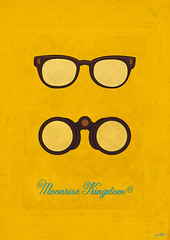…The things in Anderson’s films that recall Cornell’s boxes—the strict, steady, foursquare construction of individual shots, by which the cinematic frame becomes a Cornellian gesture, a box drawn around the world of the film, as in Moonrise Kingdom’s dressing room scene, with the little bird-girls framed by strips of lightbulbs; the teeming, gridded, curio cabinet sets at the heart of The Life Aquatic, The Darjeeling Limited, and Fantastic Mr. Fox—are often cited as evidence of his work’s “artificiality,” at times with the implication, simpleminded and profoundly mistaken, that a high degree of artifice is somehow inimical to seriousness, to honest emotion, to so-called authenticity. All movies, of course, are equally artificial; it’s just that some are more honest about it than others. In this important sense, the hand-built, model-kit artifice on display behind the pane of an Anderson box is a guarantor of authenticity; indeed I would argue that artifice, openly expressed, is the only true “authenticity” an artist can lay claim to.
Anderson’s films, like the boxes of Cornell or the novels of Nabokov, understand and demonstrate that the magic of art, which renders beauty out of brokenness, disappointment, failure, decay, even ugliness and violence—is authentic only to the degree that it attempts to conceal neither the bleak facts nor the tricks employed in pulling off the presto change-o. It is honest only to the degree that it builds its precise and inescapable box around its maker’s x:y scale version of the world…
“Films of Wes Anderson,” by Michael Chabon, in NYRB. Cue music: Let Her Dance, Bobby Fuller Four
Related articles






